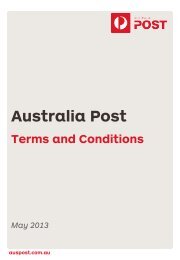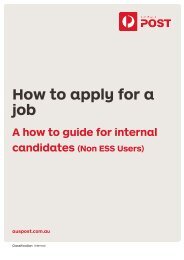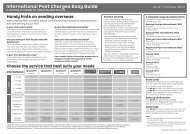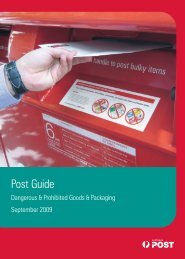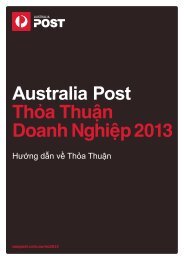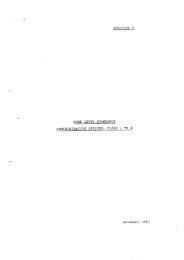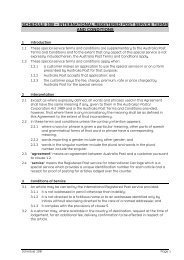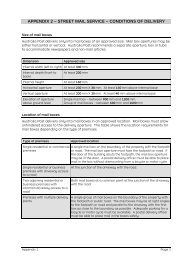2009-10 Annual Report - Australia Post
2009-10 Annual Report - Australia Post
2009-10 Annual Report - Australia Post
You also want an ePaper? Increase the reach of your titles
YUMPU automatically turns print PDFs into web optimized ePapers that Google loves.
CorPorAte governAnCe<br />
incentive rewards payable to the managing director and Ceo and other<br />
senior executives for meeting or exceeding specific key annual business<br />
objectives are linked to the annual business planning process at a<br />
corporate and individual level. Measures and targeted achievement<br />
levels are reviewed annually to reflect changes in the business priorities<br />
for the forthcoming year. the measures include financial, customer<br />
satisfaction, employee engagement and other individual measures<br />
that support the key business objectives.<br />
Before a reward is payable, a threshold must be reached, according<br />
to predefined measures. in the case of the managing director and Ceo,<br />
part of his incentive payment is deferred.<br />
the managing director and Ceo and other senior executives are employed<br />
under individual contracts of employment that are not limited to a specific<br />
duration. Continuation of employment is subject to ongoing satisfactory<br />
performance. Where australia post terminates the managing director<br />
and Ceo’s or other senior executive’s employment for reasons other<br />
than performance or misconduct, they are entitled, in the case of the<br />
managing director and Ceo, to:<br />
• a payment of 12 months’ fixed annual remuneration in lieu of notice<br />
and a termination payment of 12 months’ fixed annual remuneration<br />
less any payments in lieu of notice<br />
and, for other senior executives, to:<br />
• 90 days’ payment in lieu of notice and a termination payment<br />
calculated on four weeks for each of the first five years of employment<br />
and three weeks for every year thereafter to a maximum of 84 weeks,<br />
including the payment in lieu of notice.<br />
all of the above payments are based on annual base salary.<br />
Remuneration details for the managing director and Ceo and other<br />
key executives are provided in note 27 to the financial statements<br />
(see page 82).<br />
Remuneration arrangements for senior executives are being reviewed<br />
and a new remuneration structure is being implemented for 20<strong>10</strong>–11.<br />
External audit<br />
Under section 8 of the CaC act, the auditor-General is responsible for<br />
auditing the financial statements of australia post and its subsidiaries.<br />
the auditor-General is also responsible for auditing compliance with the<br />
performance standards prescribed for australia post under section 28C<br />
of the apC act. ernst & Young has been retained by the australian<br />
national audit office to assist in both of these assignments.<br />
the board has in place a comprehensive set of audit independence<br />
principles in relation to the external auditors. among other things,<br />
these principles exclude the engagement of the external auditors for<br />
the provision of certain non-statutory audit-related services, such as<br />
internal auditing, taxation planning, treasury policy and operations, and<br />
business and strategic planning. in addition, the senior audit partner<br />
on the corporation’s account must be rotated at least every five years.<br />
32 AustrAliA <strong>Post</strong> AnnuAl rePort <strong>2009</strong>–<strong>10</strong> | RepoRt of opeRations<br />
Internal audit<br />
australia post’s internal audit service brings a systematic and disciplined<br />
approach to risk management, control and governance processes.<br />
empowered by the board to direct a wide-ranging program of internal<br />
auditing, it has full and unrestricted access to all functions, property,<br />
personnel, records, accounts, files and other documentation.<br />
the internal audit work program is endorsed annually by the Board<br />
audit & Risk Committee, with results, progress and performance<br />
regularly reviewed by both the committee and the external auditors.<br />
the internal auditor also meets privately with the committee before<br />
each meeting, without other management present.<br />
Risk management<br />
the board has established a comprehensive risk management and<br />
compliance policy framework covering significant operational, strategic<br />
and compliance-related business risks. the framework and underpinning<br />
processes are consistent with the principles of the relevant standards<br />
(iso3<strong>10</strong>00 and as3806).<br />
as part of the risk management and compliance framework all business<br />
units provide an annual presentation to an internal Risk Management<br />
Committee on their existing and emerging risks, associated mitigation<br />
strategies and progress against their implementation. the status of<br />
higher rated risks is reported to the audit & Risk Committee each<br />
quarter. in addition, each year the status of each major compliance<br />
program is provided to the audit & Risk Committee.<br />
Risk identification, measurement and mitigation strategies are included<br />
in all business-related proposals considered by the board. there are<br />
also a number of programs in place to manage risk and compliance<br />
in specific areas such as fraud, the environment, injury prevention<br />
and management, trade practices, privacy, it, emergency procedures<br />
and business continuity planning.<br />
the potentially adverse financial impacts associated with catastrophic<br />
risk exposures are limited by the purchase of appropriate insurance cover.<br />
the effectiveness of the corporation’s risk management and<br />
compliance framework is reviewed annually by the board. to ensure<br />
the maintenance of better practice, independent external reviews of<br />
risk management and compliance processes across the corporation<br />
are undertaken every four years. the most recent such review was<br />
undertaken by Deloittes in late 2008.<br />
Internal control framework<br />
australia post’s internal control includes strategic, financial, operational<br />
and compliance elements established across multiple internal control<br />
layers. Controls include financial planning and reporting, commitment<br />
and expenditure delegations, due diligence, procurement contract<br />
tendering, expenditure gating, external performance reporting and<br />
corporation-wide risk management and internal audit practices. financial<br />
reporting and business system integrity are assured through the<br />
maintenance of extensive operating procedure policies and practices.<br />
Before adopting the annual financial statements, the board receives<br />
written confirmation from the managing director and Ceo and the chief<br />
finance officer that the integrity of the statements is founded on a sound<br />
system of risk management and internal compliance and control, and<br />
that all material risks have been managed effectively.




